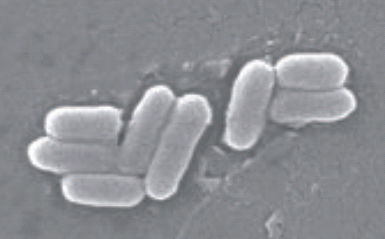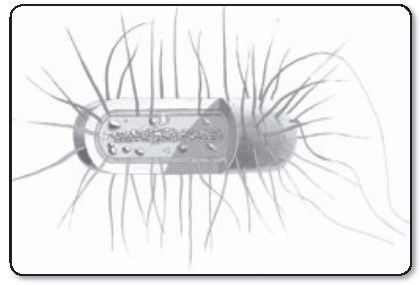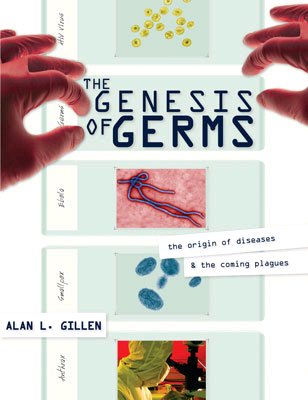Chapter 2
Beneficial Bacteria
Section 1
Magnificent Microbes

The term bacteria is a plural form of the Latin bacterium, meaning “staff” or “rod.” Bacteria are prokaryotes and among the most abundant organisms on earth. The vast majority play a positive role in nature. Bacteria digest sewage into simple chemicals; extract nitrogen from the air and make it available to plants for protein production; break down the remains of everything that dies, recycling the carbon and other elements; and produce foods for human consumption and products for industrial technology. Many biologists believe that life on earth as we know it would be impossible without bacteria. They are the Master’s magnificent microbes.
Bacteria have adapted to more different living conditions than any other group of organisms. They inhabit the air, soil, and water, and exist in enormous numbers on the surfaces of virtually all plants and animals. They can be isolated from Arctic ice, thermal hot springs, the fringes of space, and the tissues of animals. Some can withstand the searing acid in volcanic ash, the crushing pressures of ocean trenches, and the powerful activity of digestive enzymes. Other bacteria survive in oxygen-free environments, boiling water, and extremely dry locations. In short, they are ubiquitous (everywhere). The Creator must love them because they are the closest things to omnipresence on earth. Bacteria have so completely invaded the earth that the mass of bacterial cells is estimated to outweigh the mass of all plants and animals combined. They are Providence’s prokaryotic wonders.
This chapter explains the importance of bacteria to our everyday lives. It also includes a discussion of their designed structures, size, classification, environmental functions, and their role in disease. Though most bacteria are beneficial, some are harmful. Certain species multiply within the human body, where they digest tissues or produce toxins resulting in disease. Other bacteria infect plant crops and animal herds. Disease-causing bacteria (i.e., pathogenic bacteria) are a global threat to all life forms, and in the 21st century, they have already been used as agents of bioterror. Bacteria have threatened human existence over the millennia through tuberculosis, bubonic plague, typhus, pneumonia, streptococcal infections, diphtheria, E. coli, and anthrax.
Prokaryota
The prokaryotic cells of bacteria are generally much smaller and simpler in structure than eukaryotic cells (Table 2.2). Their definitive feature is the absence of a nuclear envelope separating the genetic material from the cytoplasm. Today, bacteria still outnumber other organisms, thriving in almost every conceivable habitat, but because of their tiny size, they were the last major group of organisms discovered. Some of the larger bacteria were first observed and described by Anton van Leeuwenhoek in 1676. In the 1860s and 1870s, Louis Pasteur, Joseph Lister, and Robert Koch discovered the role of bacteria in causing food spoilage and many diseases. It is also interesting to note that Leeuwenhoek, Pasteur, and Lister were all creation scientists who sought God’s thoughts (Ps. 139:17) in biology and in medicine. They sought not only to classify their newly found bacteria, but also to find useful applications to benefit mankind. Bacteria, like other living things, are classified by their morphology, molecular composition, staining characteristics, metabolic way of life, and growth characteristics. The table below (Table 2.2) gives the basic characteristics of prokaryotes.
| Characteristics of Prokaryotes |
|---|
| 1. Lack a true nucleus. DNA not enclosed within a membrane, but in a “nuclear region” |
| 2. DNA not associated with histones like in eukaryotes |
| 3. Cell structure simpler than in eukaryotes; Lack true membrane-bound organelles |
| 4. Cell walls almost always contain peptidoglycan; Chemistry of the bacterial cell wall is unique |
| 5. Usually divide by binary fission, some reproducing every 20 minutes |
In the second edition of Bergey’s Manual, prokaryotes are grouped into two domains, Archaea and Bacteria. Each domain is further divided into “clades,” each clade into phyla, each phylum into classes, and so on. Bacteria are divided into five clades. Clades refer to distinct lines of phylogeny from a cladogram. This concept is based upon assumptions of common descent and neo-Darwinian evolution. Many creationists would refer to these unrelated, large, inclusive categories as polybaramins. Perhaps the largest collections of typical bacteria are the Eubacteria and the Cyanobacteria. Both possess “true” prokaryotic cells. Cyanobacteria have cells like bacteria, but form colonies and filaments like algae, with all being capable of photosynthesis. Hence, they were traditionally referred to as blue-green algae. Clearly they are a distinct kind, defying neat, clear classification according to modern taxonomic methods. Although some creationists still place them in the alga category, we are placing them in this chapter because most biologists today classify them with bacteria. We will focus our discussion of Cyanobacteria on their role in the nitrogen cycle and their overall importance to ecology. Archaea have unique attributes and are also difficult to classify. Archaea cells have many attributes similar to bacteria, but have some characteristics similar to Eukarya.
Domain Bacteria
Most of us have been conditioned to think of bacteria as invisible, potentially harmful little creatures. Actually, relatively few species of bacteria cause disease in humans, animals, plants, or any other organisms. Indeed, once you have completed a biology course, you will realize that without bacteria, the majority of life as we know it would be impossible. Evolutionists assert that all eukaryotic organisms probably evolved from Bacteria or Archaea. They believe that Archaea were some of the earliest forms of life on earth.
Metabolism and Ways of Life
We have already mentioned that bacteria are the most numerous organisms on earth. A handful of soil may contain billions of them. They occur in habitats as remote as the sea floor, icebergs, and hot springs, or as close as your mouth. They are before us even as we speak. This far-flung distribution is possible because many bacteria have metabolic abilities not found in any eukaryote. Some carry on fermentation, others respiration. Aerobes require O2 for respiration; obligate anaerobes are killed by O2; facultative anaerobes can live in the presence or absence of O2. Some anaerobic bacteria use nitrate (NO3-), sulfate (SO4-), or iron (Fe3+) instead of O2 in cellular respiration. Most bacteria that undergo aerobic respiration yield more energy than those that undergo anaerobic respiration or fermentation.
Because of their rigid cell walls, bacteria cannot take in large food particles. Rather, they absorb small molecules that filter through their walls. Many bacteria can make any organic molecule they need by starting with only one kind of organic molecule, such as glucose or fatty acids. Others require a more complex diet. The “picky eaters” are referred to as fastidious. When conditions are unfavorable for growth, some bacteria form thick-walled, resting spores resistant to heat and drying. Most bacterial spores are not a means of reproduction, because no increase in cell number occurs. Rather, spore formation permits cells to survive adverse conditions and disperse to new locations, where a new cell may develop from the spore.
Bacteria undoubtedly owe their biological success to their varied metabolic abilities, coupled with small size, rapid reproductive rate, and ability to form resistant spores. These features permit bacteria to live in many habitats that are here today and gone tomorrow. A raindrop on a leaf evaporates in a few hours, but by then a bacterium has divided several times, and its descendants have formed spores that can blow away to new habitats.
Bacterial Anatomy

Individual bacterial bodies have one of three basic shapes, but the shapes have many variations and arrangements (left). The cells of some bacteria are spherical; some are cylindrical or rod-shaped; and others have the form of a somewhat rigid, curved rod or of a short spiral. The spherical forms are called cocci (singular coccus); the cylindrical forms bacilli (singular bacillus); and the spiral-shaped forms spirilla (singular spirillum). Each of the many kinds of true bacteria is placed in one of these three morphological groups.
Bacilli
In Latin, bacillus means “a little stick or rod,” and the bacilli have the shape of a little rod or cylinder. Individual kinds of bacilli show almost infinite variations on this basic shape. Some are so short and thick that they are nearly indistinguishable from cocci; others are long and slender. Their ends may be square-cut, rounded, or tapered to a blunt or fine point. Most of the bacilli are straight, rigid rods, but some are slightly curved and less rigid. Many species are motile, moving through liquids by means of delicate, whip-like appendages called flagella. Others lack flagella and are non-motile. Like cocci, bacilli are widely distributed, and numerous species are known. One common example of a bacillus is Escherichia coli, the common intestinal bacterium.
Cocci
The word coccus comes from a Greek word meaning “berry,” and all cocci have a spherical form like a tiny berry. Many are not perfectly round, but are flattened on one side or more or less elongated. There are many species of cocci, and they are widely distributed. One common example of a coccus is Streptococcus pyogenes, the cause of strep throat.
Spirilla
In this group are bacteria having a helical shape like a corkscrew. Some spirilla are short, comma-shaped organisms with less than one complete spiral turn; these are classified in the genus Vibrio (e.g., Vibrio cholera). Other spirilla are longer, more delicately coiled threads; these are placed in the genus Spirillum. The body of a spirillum is rigid; its motility is due to flagella. Spirilla must be distinguished from spirochetes, which are delicate, flexible, filamentous forms, having the general shape of a rather long, more or less tightly coiled wire spring. They are motile, but do not have special locomotive appendages (i.e., flagella). One common example of a spirochete is Treponema palladium, the cause of syphilis.
Size of Bacteria

Illustration of a typical bacterial cell, sectioned to reveal its internal structures.
As we have already learned, bacteria are so minute that they cannot be measured accurately by any familiar scale. A special unit of measurement, the micron (μ), is 1/1,000 of a millimeter, or about 1/25,000 of an inch. Most bacteria are smaller than eukaryotic cells but larger than the nucleus (Table 2.3). Two notable exceptions are Epulopiscium sp. and Thiomargarita namibiensis. These are quite exceptional and atypical. The first giant bacterium is over 0.6 mm long—600 μ compared to 2 μ for E. coli dwarfing Paramecium. Found in the gut of surgeonfish near Australian reefs, the bacterium is the second largest. After the discovery of Epulopiscium in 1991, another “Goliath” bacterium was found in 1999. Thiomargarita namibiensis, meaning “sulfur pear of Namibia,” was found in sediments off the coast of Africa. This bacterium is 750 μm, or a bit larger than the size of a period. Normally the fact that nutrients must enter the cytoplasm by simple diffusion limits the size of prokaryotic cells. In addition, they do not reproduce through binary fission. These observations present problems to evolutionary biologists; they cannot explain how such prokaryotic cells could evolve, and the giant prokaryotes cast doubt on current phylogenetic trees illustrating divergence of prokaryotes from eukaryotes. Table 2.3 gives examples of actual sizes of some of the best-known prokaryotes.
| Name of Organism | Size of Individual Cells | Comments |
|---|---|---|
| Borrelia burgdorferi | 11-25 µ long | Causes Lyme Disease |
| Clostridium tetani | 2-4 µ long | Causes tetanus |
| Corynebacterium dipetheriae | 1.5–6.5 µ | Causes diptheria |
| Escherichia coli | 2-3 µ long | Common bacterial infection |
| Neisseria gonorrheae | 0.8–0.6 µ in diameter | Causes meningitis |
| Mycobacterium tuberculosis | 2-4 µ long | Causes tubercolosis |
| Salmonella typhi | 1-3 µ long | Causes typhoid fever |
| Staphylococcus aureus | 0.8–1.0 µ in diameter | Causes boils |
| Streptococcus pyogenes | 0.4–0.75 µ in diameter | Causes sore throat |
| Streptococcus pneumoniae | 0.8–1.2 µ in diameter | Causes pneumonia |
| Treponema pallidum | 8-14 µ long | Causes chlorea |
| Vibrio comma | 1-2 µ long | Causes chlorea |
Design Focus 2.1
On Beneficial Bacteria
Yogurt Aging Theory: Does Eating Yogurt Prolong Life?
Yogurt, sometimes called Bulgarian milk, was popular among people of Eastern European countries. Dr. Elie Metchnikoff took note that many Bulgarian people lived to be over 100 years of age. He attributed their length of life to the yogurt they ate. He believed eating yogurt would neutralize a natural process that he called “autotoxication.” The intestinal tract harbored great numbers of bacteria that Metchnikoff thought produced toxins that slowly poisoned the body and caused premature death. Metchnikoff believed yogurt bacteria were beneficial to the intestine and would replace other microorganisms that contributed to aging. Later, experiments by other scientists found Metchnikoff’s aging theory was not supported by facts.
Metchnikoff’s aging theory is no longer accepted among scientists. However, his research on microbes in the intestinal tract contributed to our knowledge about the human body. The body’s internal and external surfaces support communities of microscopic allies. Populations of “normal flora,” or friendly bacteria, live in the colon. Normal flora refers to the bacteria, yeasts, and molds that reside inside the body as friendly residents. Their presence prevents harmful organisms from attaching and multiplying. Any pathogen, or harmful microbe, trying to settle in the intestine must contend with a well-entrenched colony of the normal flora. In places, nearly 20 million microorganisms are present per square inch, some of which make life unpleasant for newcomers. Certain friendly bacteria produce chemicals that hinder the growth of other strains of bacteria and fungi. The bacterium Escherichia coli, which lives in the intestinal tract, simply uses up the nutrients that other, less favorable types of bacteria require to live—in effect, starving out their competitors.
Experience with antibiotics demonstrates the dangers of disturbing the microbial life that normally inhabits the body. Long-term use of these substances can wipe out the friendly, normal flora of microorganisms, as well as hostile ones. If the normal flora is eliminated, pathogens can establish themselves, sometimes causing intestinal problems. Given this potential for some pathogenic microorganisms to colonize the intestine, physicians often recommend that patients drink acidophilus milk or eat yogurt. Lactobacillus acidophilus occupies empty niches in the colon until the normal flora returns, thereby preventing attachment of pathogens.
After World War II, many people became health-conscious and, as a result, yogurt became a popular food among middle-class Americans. This growing appeal of yogurt stimulated further scientific investigation of its value in human health. The nutritional and therapeutic aspects of yogurt have long been debated in the scientific community. Several scientists assert that eating yogurt has no more positive effects than drinking milk. In fact, one writer reports that eating yogurt for health benefits is overrated because Lactobacillus bulgaricus will not colonize the intestine under normal conditions and cannot compete with normal flora. Some food scientists assert that yogurt may taste good and provide the same nutritional benefits as milk, but yogurt doesn’t really help intestinal distress, nor will it prolong your life.
Recent scientific data provides evidence that yogurt does relieve intestinal distress during antibiotic therapy. In a controlled study, physicians reported that L. bulgaricus may not be able to compete with normal flora under ordinary conditions, but it does appear that L. bulgaricus will colonize the colon during and after the use of antibiotics. Bacteria in yogurt also may serve as a natural antibiotic. Evidence from this study indicates that not only will lactobacilli grow temporarily inside the intestine until the natural flora returns, but they will also prevent diarrhea that is associated with an antibiotic called erythromycin. These researchers report that the side effects of erythromycin, such as abdominal distress, stomach pain, and gas were less common among patients taking fermented yogurt during antibiotic treatment than patients taking pasteurized yogurt.
Another physician, in a review of animal studies involving yogurt and antibiotics, reported the nutritional and therapeutic value of lactobacilli in animal and human diets. Nutritionists have known for some time that yogurt is nutritious because of a high content of protein, riboflavin, and calcium. However, only recently have scientific studies shown that the lactobacilli increase the quantity, availability, digestibility, and uptake of nutrients.
This increase in nutrients can be explained by the finding that lactobacilli present in yogurt digest proteins to smaller, more readily assimilated substances. Yogurt bacteria also help the body to synthesize vitamins more efficiently. Physicians report therapeutic uses for yogurt bacteria, such as prevention of various intestinal infections caused by harmful microbes and diarrhea caused by antibiotics.
In 1992, studies by Dr. George M. Halpern at the University of California suggested that yogurt may boost the immune system. Eating yogurt may help you resist infections, such as colds and other upper respiratory infections. The study found that yogurt boosted the production of gamma interferon, a substance that helps fight infectious disease. A control group received no yogurt and two groups of people were given yogurt to eat. A second group ate yogurt with active bacterial cultures and the third group received yogurt that was heat treated to kill the active cultures. Only the group that ate yogurt with living L. bulgaricus and S. thermopiles had an immune system that was boosted. In this group, those who ate two cups of yogurt a day for four months had five times more gamma interferon than non-yogurt eaters. The Houston Post, reporting on this study, concluded, “To boost your immune system, increase your cultural exposure to yogurt.”
In summary, eating yogurt has several nutritional and therapeutic benefits. Yogurt is nutritious because it is high in protein, riboflavin, and calcium. Yogurt also helps the body synthesize vitamins more efficiently. Eating yogurt is recommended during antibiotic usage to produce the same effect as acidophilus milk. Some antibiotics, during their administration, wipe out friendly bacteria, as well as the target pathogens. Bacteria in yogurt help the human body by temporarily occupying an empty niche during antibiotic treatment. These bacteria prevent unfriendly molds, yeast, and bacteria from colonizing the intestine. The value of yogurt to people trying to lose weight depends upon what type of yogurt is eaten. Yogurt made from skim milk and artificial sweeteners is low in calories, but yogurt made from whole milk with sugar and syrupy fruits is high in calories. The aging theory now is largely discounted, but many microbiologists believe that eating yogurt aids in good health by boosting the immune system, by providing the body with essential nutrients, and supplemental therapy during medical treatment. Although eating yogurt may not prolong your life, it may enhance the quality of your life. The chances of experiencing diarrhea, gas, and abdominal pain are reduced while taking antibiotics, not to mention the positive nutritional value and the enjoyment of eating good yogurt!
The Genesis of Germs
Professor Alan Gillen shows that constantly mutating diseases are proof for devolution rather than evolution.
Read OnlineRecommended Resources

Answers in Genesis is an apologetics ministry, dedicated to helping Christians defend their faith and proclaim the good news of Jesus Christ.
- Customer Service 800.778.3390
- © 2024 Answers in Genesis



